If Noah were a gardener he would never have taken 2 aphids, 2 nematodes, 2 Leaf miners,………………………………………….. on board the Arc.

Insect Attacks:
Aphids: Aphids you say, Aphidian comprise of some 1360 odd species with more being discovered in remote places of the world or in rainforest jungles. So which one is giving you the headache? Aphids love nitrogen, soft leaves and stems that high nitrogen consuming plants produce. High nitrogen will speed the sap flow up, sugar production and speed the reproductive cycle of the aphids.
Let’s look at the aphid’s life cycle. The eggs hatch in early spring as the weather warms up. The females have wings and after they do what they have to do, to reproduce fly to a preferred host plant to feed. 7 to 10 days later she gives birth to 40 to 60 live young which are all females. This continues until the weather begins to cool down at the end of autumn. Now for some reason the last batch of young produced are both male and female. The females lay eggs which lay dormant over winter. As you can see if there is no biological control 10 aphids on your favourite tree become 400 to 600 in 7 to 10 days and by the next generation you have 16,000 to 36,000 of the little sap suckers sucking the hell out of your garden. The next generation that comes along will produce around 2,160,000. What in the hell are you going to do?
On the first site of aphids in the orchard we immediately phoned Bugs for Bugs and bought a shipment of green lace wings. By the time they arrived within the week lady birds would be seen to ram the lesson home the green lace wings are ferocious eaters and reproducers. After two years of purchasing the green lace wing, our orchard had reached a balance. When we first see the aphids we knew within a week the lady birds and Green Lace Wing would appear naturally.
Lady bugs lay 800 to 1,000 eggs over the 3 months of their lives and reside close to their food source of aphids or mites. The eggs hatch in 2 to 14 days. The lavae have 4 instars before it pupates. After 7 to 10 days as pupae the adults emerge. They winter beneath rocks, logs or even coarse mulch in natural bush land. It is important to have natural landscape around to keep the balanced cycle going. Lady bugs are general insect eaters having a wide variety of prey to live on including red spider Mite, white fly, leaf hoppers, leaf miners, small caterpillars, beetle larvae, mealy bugs and the eggs of other lady bugs like the 28 spotted lady bug.
Green Lacewing will lay 300 to 500 eggs over the month of their lives and reside close to their food source of aphids. The eggs hatch in 3 to 6 days. The lavae have 3 instars before it pupates. After 10 to 14 days as pupae the adults emerge. They winter under rocks and logs in natural bush land. It is important to have natural landscape around to keep the balanced cycle going. Lacewings are more fastidious eaters which prefer to eat aphids and will eat 600 to 1,000 aphids in their life time. They will also eat red spider Mite, white fly, leaf hoppers, leaf miners when they approach to close and small caterpillars.
Hover flies are a group of insects which often mimic wasps in size and colour. While the adults are pollen or nectar feeders the larval stage are interesting in that different specie diets vary from decomposing vegetable matter, decomposing animal matter to being insectivorous. The insectivorous species are of great benefit to humans especially in the control of aphids and leaf hoppers. (See article garden Friends and Earthworms.)
Beetles Larvae:
beetles are the most common insect on the planet. Very few beetles ever get to the stage of being a nuisance in the garden. In fact their colours are welcomed in the garden. Most beetle larvae eat vegetable matter from dead leaves to live leaves and roots.

Small beetle larvae that feed on leaves will be preyed upon by Lady Bugs Lace wing and parasitic and predatory wasps.
- Make it a safe environment for birds. Remove all bird predators from the garden, which means a cat free environment.
- Water. Bird baths and bird water stations were placed throughout the orchard and kept topped up. Many had to be hidden so small birds could get to them but not larger more aggressive birds and predatory birds.
The notable exception the above are the notorious Stink Bugs, the 28 spotted Lady beetle and the Curcubit beetles where the beetles also consume the leaves of plants.
Other beetle larvae often consume the roots of plants or are found plentiful in compost heaps. A good example are the white grubs known as scarab beetle grubs.

Caterpillars:
Attacks are as varied as the type of moth or butterfly and the plants they feed on. Fortunately in the organic garden a balance of predators are available to come to your assistance.
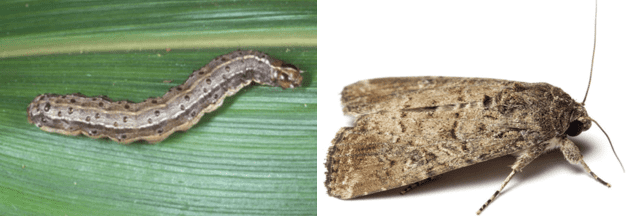
The first method of attack should be the ambush method. Locate, pick off and squash.
Failing nature’s creatures having the numbers or the spread from a neighbor’s garden help is at hand. Dipel has been around for a long time and is both safe and very affective. Bacillus thuringiensis is a bacterium that eats the gizzards of those poor hairless little caterpillars. They stop eating immediately and once they die the bacteria moves on. The problem with dipel it also dies once the food supply dries up and it is non specific to just the caterpillars you wish would vacate your garden. Another caterpillar virus Nuclear polyhedrosis virus is specifically targeted at the Heliothis moth.
Army grubs have security in numbers and often emerge at night to feed in the tree tops. The best method for preventing the trees from becoming defoliated by the Cape Lilac Moth which feast on Melia azedarach is to be vigilant in late January and February and again in October for a lesser attack when the caterpillars are up and about. The caterpillars feed at night and return to a dark cool place out of the sun during the day away from the tree. When they are noticed, make a cloth skirt for the tree. After dark tie the bottom securely around the trunk so they cannot crawl out the bottom. With a row of pegs tie the top off 100mm out from the trunk and about 0.5 meter above the ground so a funnel is formed. Place some old black rags in the bottom so the caterpillars can hide beneath out of the sun. The following morning it is just a matter of picking them out with gloves and squashing them. If you are too squeamish, get the little lady to do it for you. Also spray the trunk to a height of one meter with dipel. This helps to kill any of the little grubs that may fall to the ground from outer branches over night.
Attract birds to the garden is one of the best biological controls around for gardeners. I deployed this method to great affect and never had the need to spray the orchard for over 10 years. I was told a secret, years ago on how to attract and keep birds in the garden.
- Make it a safe environment for birds. Remove all bird predators from the garden which means a cat free environment.
- Water. Bird baths and bird water stations were placed throughout the orchard and kept topped up. Some had to hidden so small birds could get to them but not larger more aggressive birds and predatory birds.
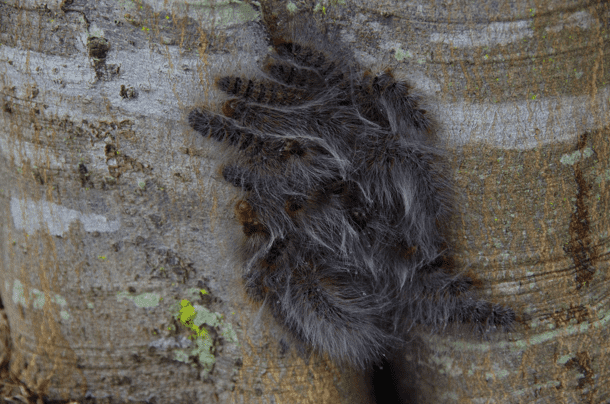
I have always looked after nature and lawn grub has never given me any problems. It is usually a sign of too much chemical fertilizer coupled with the application of toxic poisons which kill the predatory wasps, flies and birds at the same time as the pest. This then gives the pests the upper hand to again mount an attack knowing there are no predators around. Frequently my neighbour’s yards were decimated and ours was left alone. Balance is what nature is best at.
There are a number of wasps and flies that parasitizes the grubs. The wasps include the endoparasite Apanteles sp. that feeds inside the larvae and is seldom seen until the 10 to 30 wasp larvae emerge from the armyworm. They spin their small oblong fluffy white cocoons near the armyworm, often in a cluster. The ectoparasites attach and feed externally.
The Ichneumonid wasps are the most common and certainly the most beautiful little wasp. Dressed in red and black with long dragon fly like wings, it is often seen hovering over the lawn looking for a meal. When the grubs are around they can often be seen hovering and flying in large numbers over lawns and pastures searching for caterpillars on which to lay eggs. The larvae of the wasp grow from 8mm to 10mm when mature. The wasp’s cocoons are constructed of tightly woven black fibers and are oblong. They can be found in the cell under the soil constructed for pupation by the army worm larvae.
Another group of predators to help keep the bugs under control are the predatory flies which belong to the family Tachinidae and again are endo-parasitic. The eggs are laid on the skin of the armyworm larva, and the larvae burrow their way in to the grub’s gizzard where it immediately starts to feed internally, like on one big larder. Usually only one of these develops to maturity, and the fly pupa is found within the army worm pupa.
Leaf Hoppers:
These are small sap sucking triangular hoppers that spring away from immediate danger. They don’t usually create problems and are closely related to the cicadas. The problem usually lies in that they can spread disease from one plant to another. Large numbers have been known to damage vineyards and other members of the Vitacea family. Their saliva can also cause problems for plants like a bee sting to a human.

Their cycle begins at the egg which is laid in the soft stems or leaf blades of plants. There are 3 instars stages before they pupate. The adults emerge in 7 to 10 days. The cycle lasts a little over a month so several cycles a year will be produced.
The praying mantis is particularly fond of leafhoppers. Their egg sacks can be purchased from organic bug growers.
Hover flies are a group of insects which often mimic wasps in size and colour. While the adults are pollen or nectar feeders the larval stage are interesting in that different specie diets vary from decomposing vegetable matter, decomposing animal matter to being insectivorous. The insectivorous species are of great benefit to humans especially in the c control of aphids and leaf hoppers. (See article garden Friends and Earthworms.
- Make it a safe environment for small birds especially honeyeaters. Remove all bird predators from the garden which means a cat free environment.
- Water. Bird baths and bird water stations were placed throughout the orchard and kept topped up. Many had to hidden so small birds could get to them but not larger more aggressive birds and predatory birds

.
Leaf Miner:
Leaf minor is a more aggressive insect where synthetic nitrogenous fertilizers have been used as they cause softer new growth that is longer.
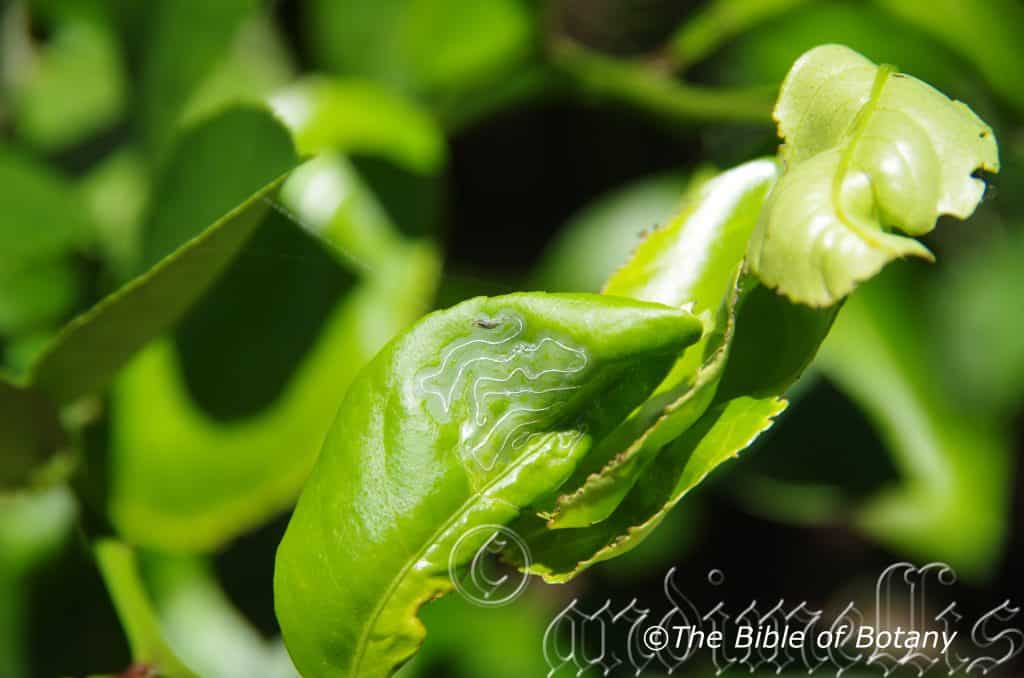
There are many varieties of leaf minor and each one prefers a different host plant. The most prevalent one in Australia damages the young leaves of Rubiaceae family whether native or exotic. The larvae tunnel below the leaf surface to eat, leaving snaking trails of dead tissue behind. When they are ready to pupate they drop to the ground where they bury themselves to reemerge 10 to 15 days later or to hibernate over winter. There maybe several generations in a year.
Trees generally grow out of the problem in 2 or 3 years. A well balanced garden will host many predatory wasps and arthropods. There are several methods to control the insects without using chemicals like purchasing commercially available parasitic wasps which are cheaper and easier to use than dangerous pesticides. Neem oil is useful in disrupting the life cycle of the leaf minors meaning fewer insects to breed in the next generation.
Mealy Bugs:
These are white cottony sap sucking bugs. Mealybugs belong to the scale insect group, of which they make up about a third of known species. They have a worldwide distribution, occurring in all the continents except the Polar Regions. Mealybugs are one of the most damaging economically groups of insects known to humans because they attack many cultivated food and ornamental crops. They are particularly common on Rubiaceae and some Cissus specie.
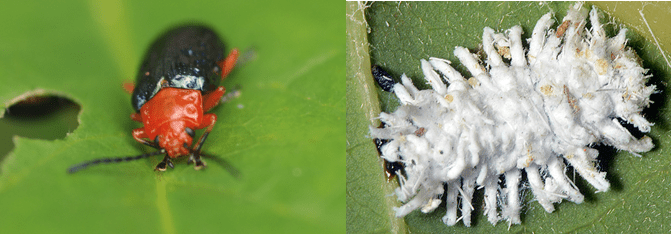
Mealybugs are so named because many of the known species are covered in a whitish ‘mealy’ wax, which helps retard the loss of water from their soft bodies. They generally prefer warm, humid, sheltered sites away from adverse environmental conditions and natural enemies. Different species of mealybugs prefer different feeding environments from stems fruits, flowers or seed heads.
Moist humid areas without much air flow are favoured by this sap sucker. Mealybugs can build up in huge numbers in a very short time when these conditions are present. Like most sap suckers they insert their straw-like mouthparts, known as ‘stylets’, into the plant tissue. Feeding damage can be either by direct removal of plant fluids and nutrients, and or by the excretion of toxic salivary compounds into plant tissue which causes a reaction bringing certain nutrients to the affected area.
Honeydew the excrement of the mealy bug’s feeding process is a perfect growth medium for sooty mold fungi which I will deal with later. These moulds damage plants by covering leaves and reducing light available for photosynthesis.
Australia has a number of native mealybugs (and other scale insects) which are now worldwide pests, the worst being the Long-tailed Mealy bug (Pseudococcus longispinus) and the Citrophilus Mealy bug (Pseudococcus calceolariae). One of the more interesting mealybugs occurring in Australia is the Golden Mealy bug (Nipaecoccus aurilanatus), which thrives on the Norfolk Island Pine (Araucaria heterophylla) and other araucarias. This mealy bug has a dark purple body with a vivid yellow longitudinal stripe of mealy wax on its dorsal (upper) surface. The insects may be seen nestling under the leaf scales of the Norfolk Island Pine with affected trees are immediately recognizable by their black coating of sooty mold.
Various species of ants farm mealybugs which in affect makes exasperates the situation in much the same way that humans farm cows. In return for honeydew, the mealybugs are given shelter in the form of thatches constructed by the ant from pieces of dead plant material, soil, etc. The thatch is usually found in the axils of plant leaves. Most species of ants that farm mealybugs also aggressively defend their mealybugs from predators and parasites. Ants literally milk the mealybugs by stroking their abdomens. They respond by exuding a drop of honeydew.
Most mealybugs (especially pest species) have numerous, often overlapping, generations per year. Like all insects, their development is dependent on temperature. There is a threshold temperature for the different specie. Below that temperature development ceases; total dormancy, or is slowed to greater or lesser degrees quiescence. Above that temperature development is slowed or ceases all together.
If the temperatures remain elevated for prolonged periods, insect mortality increases exponentially with a consequent depletion in the population size. Mild to warm humid conditions are therefore favourable to insect development, and mealybugs are no exception to this rule. Summer temperatures ranging from 22 degrees to 26 Centigrade with a high relative humidity offer the optimum reproductive environment for mealybugs in Australia consequently their populations have 2 peaks every year one in spring and then again in autumn.
The eggs are laid singly or in small clusters. The female Long-tailed Mealy bug has been recorded laying up to 200 eggs in her lifetime. Egg clusters are usually embedded in a cocoon of waxy filaments, with the structure varying between species, from tightly packed to loose.
On hatching, the juveniles, crawlers immediately seek suitable feeding sites in sheltered areas. The juveniles progress through 5 instars before reaching adulthood. In the case of the males, the last juvenile instar pupates in a silk cocoon, and emerges as a winged adult. Adult males do not feed, having no mouthparts, their sole purpose is to consummate their genes.
The CSIRO research has shown mealybugs have high reproductive capacities and multiple generations in a year and show potential to become resistant to pesticides over a short period of time.
Biological agents: Good organic biological control for mealybugs is at hand. The release of parasitic wasps like Leptomastix dactylopii and Anagyrus fusciventris into the infested areas have proven to be very affective and cost efficient. The wasps lay their eggs into young mealybugs, on the newly hatched instars. The wasp larvae feed on the internal fluids of the mealybugs killing it when the wasp larvae pupates thus breaking the reproductive cycle without damaging the environment.
Despite the predatory ladybird beetles like Cryptolaemus montrouzieri devouring many species of mealybugs they are not as effective as the parasitic wasps in controlling large numbers. Cryptolaemus specie are most effective when both it and mealybugs are present in large numbers and in conjunction with the parasitic wasps. The wasps are usually species specific and are still currently very difficult to mass produce.
Predatory insects and mites are available from a number of companies in Australia. For your nearest supplier, please contact the Australasian Biological Control Association.
They will never be eliminated but fortunately they are easy to control.
The lady bug Cryptolaemus montrouzieri is another predator of mealy bugs. Cryptolaemus montrouzieri larvae look similar to mealy bugs covered in a white cottony cloak but are much larger. The females lay 300 to 500 eggs during a 3 month period. The eggs hatch in 2 to 14 days depending on weather conditions. The larvae have 4 instars before it pupates. After 7 to 10 days as pupae the adults emerge. They over winter under rocks and logs in natural bush land, It is important to have natural landscape around to keep the balanced cycle going. This lady bug has a specific diet liking for mealy bugs and wax scale insects.
Nematodes:
Nematode cause soil born diseases to enter the roots where they have been damaged. Poor drainage, excess salt, improper watering and damage caused by other soil born organisms will affect trees in much the same way as the citrus nematode which can be quite prevalent.
Nematode Life Cycle
Symptoms associated with the presence of nematodes are wilting, lack of vigor, poor fruit production, small fruit size, and poor response to watering and fertilization.

The rotation of crops or mixed plantings is the best method of control especially where certain annuals can be planted and dug into the soil. Meloidogyne sp. or root knot nematode are particularly aggressive but are easily controlled.
Some cover crops release chemicals into the soil either when growing, after they die or when dug into the soil. This release of chemicals is called allelopathy. Tagetes patula or Tagetes erecta better known as French and African marigolds are two excellent plants for nematode control and for reducing their numbers by producing a root fumigant called alpha-terthienyl. One we used at the time of planting; as a preventive measure in the orchard and gave good results was Tagetes minuta or stinking roger. It prevail with self seeding in patches for several years
Forage mustards or Brasica specie are another group when dug back into the soil when green decay to give off glycosinolate which then breaks down to form an unstable cyanide. Many plants take the soluble cyanide up and bingo dead nematode.
Cereal husks are another good deterrent so if they are available use them as mulch.
Psyllids:
Psyllids and the associated black mould seems to be the gardeners most dreaded insect pest but really control is simple and affective. But let’s first look at the life cycle of Psyllids so you understand why they seem to be the scourges of good gardens.
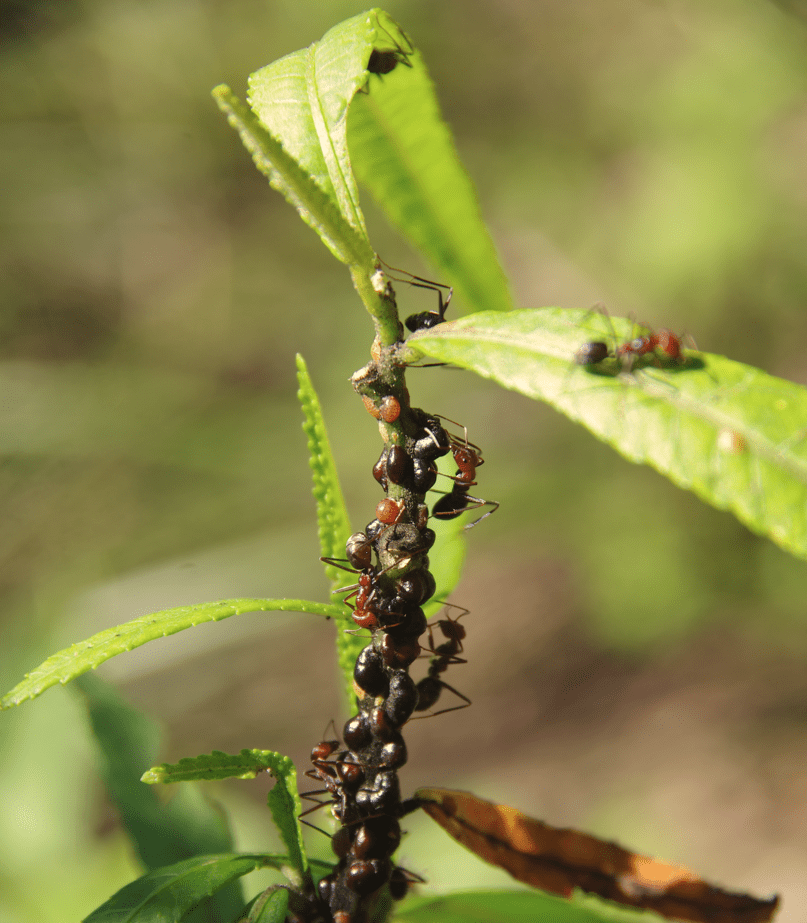
Psyllids are tiny insects which live in colonies and produce a protective waxy hutch to live under. The Psyllids excrete honeydew as they feed on sweet saps from the leaves. The hutches protect the psyllids from extremes in temperatures, dust, wind, attacks by natural enemies and chemical insecticides. When its natural enemies have been interfered with psyllid populations can build up in large numbers very quickly, and the tree can look terrible especially when the dreaded black mould appears and feeds on the sweet honey like Psyllids excrement. Psyllids by the way are edible and taste like bees was wax.
Most Psyllids are host specific which means the specific Psyllid that attacks Syzygium australe cannot live on any other specie of tree.
Adult Psyllids fly between leaves in search of mates, food, and egg-laying sites. This is when they are most venerable. The female psyllid will lay her small orange-brown eggs in tightly packed clusters of up to 50 eggs per cluster, on the margins of a leaf. Females can lay a number of egg clusters. Eggs within a cluster will hatch simultaneously. The wingless juvenile Psyllids or nymphs emerge and move a short distance across the leaf where they settle down to feed in a group. As the psyllid nymphs feed, they excrete honeydew (water and unused plant sugars) and two sets of wax like filaments. The honeydew fills up the spaces between the curling filaments, forming the lerp or hutch. The nymphs go through several moults until they reach the pre adult stage. At this stage they emerge from under the lerp and undergo their final moult to become adults, attaching themselves to the leaf tissue while the moult takes place. After expanding their wings, the adults feed and fly off in search of mates and the cycle starts all over again.
In the earlier stages of lerp formation, the lerp is vulnerable to moisture, being mostly a dehydrated sugar solution and wax, the lerp absorbs water, and starts to flow over the leaf as a sugar solution. While this deprives the psyllids their protective covering, it also has dire consequences for the leaves themselves. Since the sugar solution blocks the leaf’s pores which are needed for respiration. This causes suffocation of the tissue underneath or the inability of the plant to photosynthesize properly.
Psyllids can cause the trees to totally defoliate, but usually the damage is less. The greater the Psyllids load, the greater the defoliation can be. This is particularly noticeable in some specie of Eucalyptus like Eucalyptus grandis on the mid north coast near Coffs Harbour and some specie of Ficus species like Ficus macrophylla near Wellington Point on Moreton Bay.
Chemical Control: First the use of pesticides is unacceptable because of the broad spectrum of insects and spiders affected; including beneficial specie which compounds the initial problem as the nymphs are protected by the waxy hatch. This is virtually a waste of time, money and environmental murder of beneficial predators.
Secondly the large amounts of insecticide needed to treated a single tree and the consequent high risk of off-target spray drift to neighbours is a real problem.
Thirdly the injection of systemic insecticides into the trunks of some trees like Ficus specie will badly damage the figs fruit. Here there are symbiotic wasps that can be exterminated which will lead to a decline in fruit set for several years, maybe even decades. This in return starves or poisons birds, flying foxes and other native fauna. The drilling process itself can lead to the invasion of pathogens through the injection holes at a later date.
Biological Control: The leaves that are infected with Psyllid cause the ugly looking pimples on the young leaves and shoots of the trees.
The use of systemic poisons is not recommended by the author especially if birds are attracted to the garden. The best methods of control are long term and consist of supporting an environment that creates a balance in predatory insects to control the Psyllids. Other methods of control include not over fertilizing the plants which produce soft growth which is more susceptible to Psyllids attack. By not to developing a monoculture garden as isolated plants in a mixed planting create a better balance and help deter such outbreaks.
The young psyllids are attacked by a number of natural enemies. It is parasitized by Psyllaephagus species of wasps. The female adult wasp lays an egg into the Psyllids nymph before the lerp becomes impenetrable to the wasp. The wasp larva hatches and develops inside the living psyllid nymph. The Psyllids nymph is killed when the wasp pupates to become an adult. It is important to ensure its environment is close at hand so mulch fallen psyllid affected leaves near trees so that the wasp can emerge and continue to parasitize the Psyllids.
Other hunters of Psyllids include the beautiful Lacewing and ladybirds while their larvae also feed on the Psyllids nymphs.
Spiders which build their webs in trees account for a large number of adults and other small flying insects becoming entangled and eaten.
Birds like swallows, have been observed flying around badly affected trees when adult psyllids are numerous, and eat adult Psyllids.
Birds are also a major source of control especially the smaller honeyeaters and the small Silver Eye particularly the common Silver Eye (Zosterops lateralis) is one of the best defenses in combating Psyllids.
The bell miners or Bellbird (Manorina melanophrys) and the not so popular Noisy Miner (Manorina melanocephala) are also keen scavengers of Psyllids.
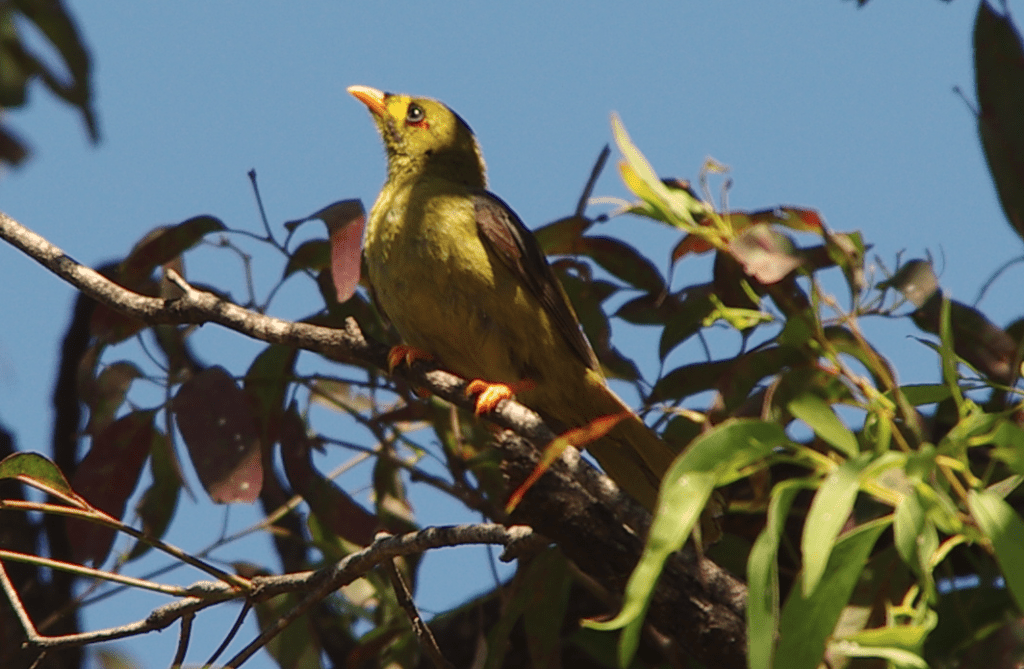

Red Spider Mites:
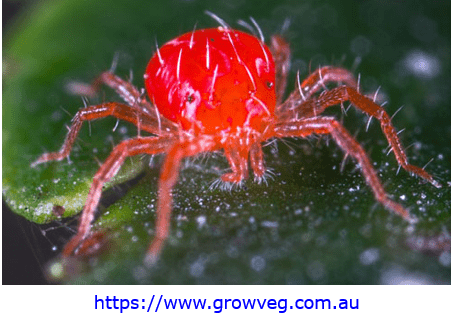
The red spider mite is just one of several mites that can have explosive populations. Most of them eat the chlorophyll in the leaves of plants. These are prolific breeders in hot humid areas of Australia. They start life as an egg hatching after 3 to 5 days. The female will live for 2 to 4 weeks and lay 10 to 20 eggs a day. A single female can be responsible for a million offspring in a month if not stopped. This rapid reproduction has led to the mites becoming resistant to many pesticides which in return lead to greater infestations.
Control of spider mite is another area that organic growers have a huge advantage over hazardous chemical users. Most of their predators over winter in compost, leaf litter and animal manures close to the dinning table. This means your garden already harbours resident sniper predators, on call and ready to breed as soon as the pests arrive for dinner. The absence of pesticides herbicides and fungicides gives them a great advantage as they are healthy where as their meals maybe coming from an already sick environment.
However if the numbers are bad and uncontrollable then Phyoseiulus persimilis and Typhlodromus occidentalis can be purchased from “good bugs”. (www.goodbugs.org.au) (www.beneficialbugs.com.au )
Snails & slugs:
These pests prefer cooler moist weather and frequently are most damaging in temperatures ranging from 15 degrees to 25 degrees. The most common culprit is Cantareus aspersus which prefer temperatures ranging from minus 3 degrees to 30 degrees. They will shelter from sunlight and drying heat during the day in summer only coming out if it is cool and moist or on warm frost free nights in winter. Snails and slugs especially snails won’t be a problem on strongly acid soils.

Common introduced garden snail, Cornu aspersum – Photo Andrew Donnelly https://australian.museum/learn/animals/molluscs/garden-snail/#gallery-thumbnail

If Cantareus aspersus are plentiful and no one in the neighbourhood is poisoning them then here is your chance for real organic French or Italian cuisine. Place the culprits in an enclosed container and feed them flour. Snails are particularly fond of cornmeal and are soon transformed magically from garden pests to escargot. Sort of like “Killing 2 birds with the one stone.”
If it is practical ducks are fantastic for the control of snails and slugs.
A small duck on an average to large building block will see the yard free of the pests in a very short time. The benefit here is the eggs will take on a deep orange yoke. The down side is the ducks will eat everything they can get their little beaks around. Caterpillars, beetles, scraps and your vegetables will also be consumed so be aware if you want them.
Beer is another good attractant. Place a saucer of beer out in various locations around the garden and partially cover it with a roof. This way the pests will be happy to stay put even during the day. The following morning it is a matter of lifting collecting and squashing or purging for the table.
Orange peels covered over with a small dark coloured roof will attract the pests for several days and keep them there. Again like the beer, the following morning it is a matter of lifting collecting and squashing.
13 & 26 Spotted Lady Bug:
Are usually in plague proportions in rural areas in the hottest part of the year before good rains arrive. They would arrive at our farm as the squash commenced flowering. The first year they ate their way through a quarter of a hectare of squash and no matter how many we killed they had back up numbers until the last leaf was devoured some three to five days later.

Birds are the best method of control with other predatory lady beetles.
Stink Bugs:
Stink Bugs are members of the Pentatomoidea family of insects. There are 550 named specie of Stink bugs in Australia. Stink Bugs rarely become a major problem however even small numbers can cause considerable damage to young plants.

If a stink bug is mishandled or threatened it usually releases a liquid from specialized glands on the underside of the thorax between the second and third pair of legs. The offensive smell is the bugs protection against carnivores and prevents it from being part of the predators dinner. If the liquid is accidently rubbed into the eyes or on the skin washing in tepid running water until the smell or pain has been removed is usually satisfactory.
It is the aldehydes, trans-2-decenal and trans-2-octenal that cause the powerful aroma. The trans-2-decenal, also known as decenaldehyde is described as having a “powerful waxy orange aroma” Simply put aldehydes are a Carbon at the center with a double bond to Oxygen and 2 Hydrogen atoms. The simplest form is formaldehyde.
These two compounds surprisingly are used in the food industry to add flavor and aroma to your food. I can assure my readers some 45 years ago while feasting on Mulberries (From an unsuspecting resident in Manly Queensland without their permission) I accidently placed a stink bug in my mouth and began chewing. That taste stayed with me for nearly 40 years. Every time I saw a mulberry the flavour of that unfortunate day repeated itself. After 40 years I again finally ate mulberries but I still check the fruit for stink bugs.
Traces of many aldehydes are found in essential oils and often contribute to their favorable odors. Cinnamaldehyde is the essential aroma in cinnamon and vanillin is the essential flavour of vanilla. Now knowing all this maybe I should have enjoyed my Mulberry-Stink Bug combo?
The life cycle of a stink bug starts with the mating which is quite conspicuous and long lasting. The bugs are attached at the rear end and will stay that way for several hours at least with the Harlequin beetles. The female stink bug lays 30 to 50 eggs on the under side of leaves on the host plant. The nymphs look similar to the adults, but are wingless and usually much flatter. The instars go through 5 stages to reach adulthood.
The most affective way to control Stink bugs is to encourage parasitic wasps into the orchard or garden. We never had more than a handful on 5 hectares of citrus surrounded by bush after the initial period prior to the orchard reaching a balance.
Below is a short list of the more beautiful members in the family including the common Citrus Stink Bug which can become a problem in orchards and home gardens where poor management or chemicals are or have been used.
Bronze Orange Bug - Musgraveia sulciventris
Body length: 24mm to 27mm in length.
Habits: Slow moving, stay at the same spot for days. The eggs laid are on leaves of the host plant.
Habitat: Citrus plants oranges, lemons and limes. It is naturally found on the native finger limes.
Status: Common, minor pest in garden and commercial orchards.
Nymphs are a pale orange and very flat.
Cotton Harlequin Bug - Tectocoris diophthalmus
Body length: 19mm to 22mm in length.
Habits: Feed on young shoots. Eggs laid on stem, female guards eggs.
Habitat: It feeds on native Hibiscus and have taken a liking to the exotic Hibiscus in the Malvaceae family.
Status: Common but rarely problem some on mature plants.
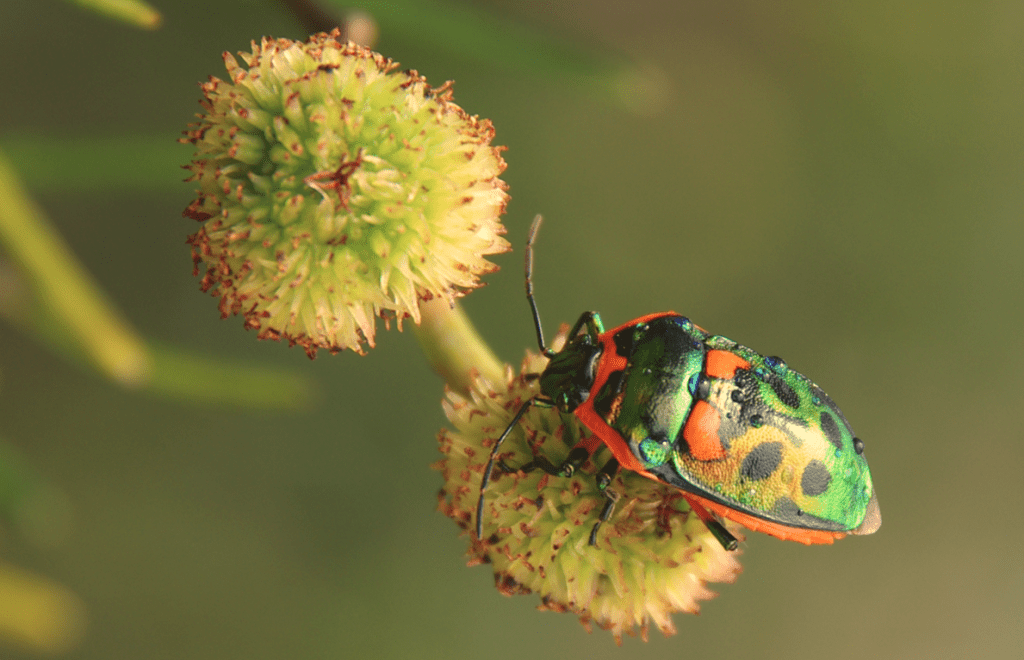
Metallic Shield Bug - Scutiphora pedicellata
Body length: 14mm to 16mm in length.
Habits: It feeds on vegetable, garden plants, trees and fruits.
Habitat: hides in leaf letter or under bark.
Status:

Green Jewel Bug - Lampromicra senator
Body length: 10mm
Habits: It is a relatively good flier for a stink Bug.
Habitat: It has been found on various Acacia species.
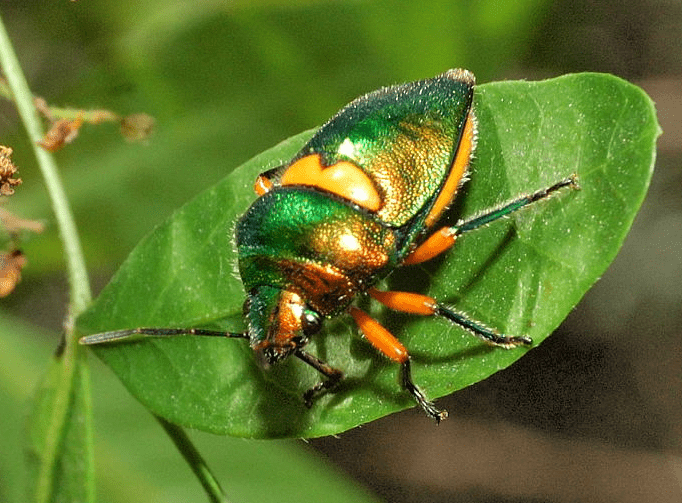
Ground Shield Bug - Choerocoris paganus
Body length: 12mm
Habits: It runs quickly across and beneath forest litter.
Habitat: Probably eats freshly fallen leaves on the ground in rainforest.

Pale Cotton Stainer – Dysdercus sidae
Body length: 9mm to 12mm
Habits: It often congregates in small colonies especially when breeding.
Habitat: It is found on various Hibiscus species.
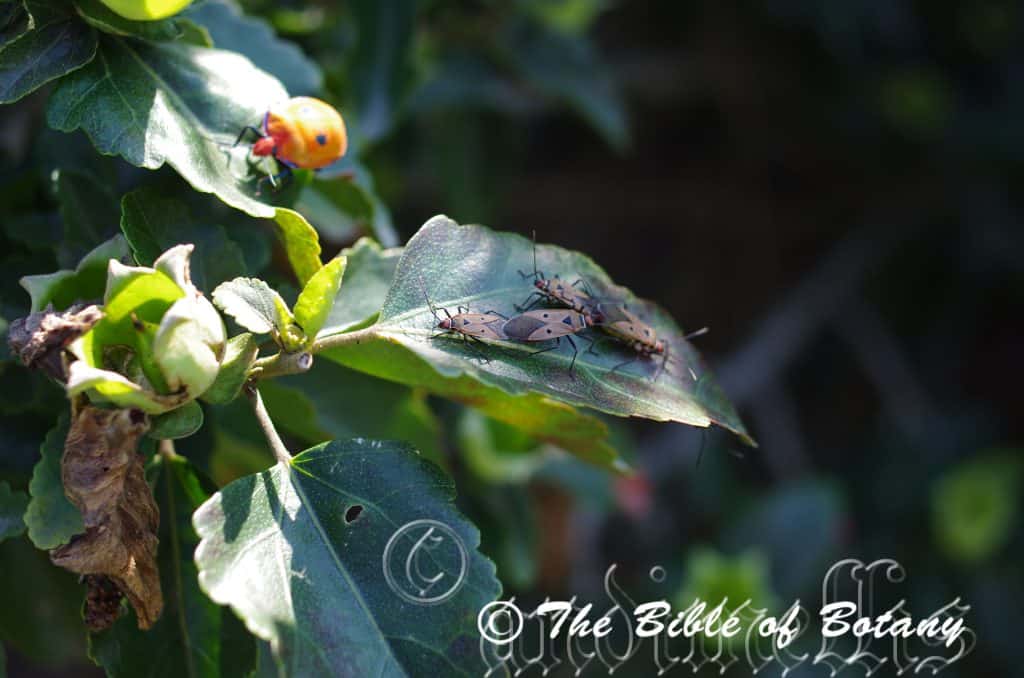
Pink Wax Scale:
Though damage is usually light they look awful and remove the real vigor of the plants. Ceroplastes rubens is very difficult to remove with chemicals and is a consistent problem for conventional farmers who keep upping the dose of pesticides to combat the enemy. Like America dropping huge bombs to dislodge a few militants and killing everything within range. The insects have a waxy coating over the body which repels insecticides, their protective clothing. The organic farmer stands quietly by, makes a simple phone call and when his parcel arrives of Anicetus beneficus which is the superior parasitic wasp, Metaphycus varius, Scutellista caerulea or Coccophagus ceroplastae he safely distributes them throughout the orchard and allows them to do the work at one tenth of the time and one tenth of the cost.

Other Predators include the lady bugs, Rhyzobbius ventralis, Cryptolaemus montrouzieri and Harmonia conformis are better at controlling the pests at the larvae stage when they are most vulnerable.
Weevils:
Are both friend and minor problematic experiences for the gardener. They very rarely become a problem but are at the forefront in controlling Patterson’s curse (Echium plantagineum) and water hyacinth (Eichhornia crassipes). Their main intrusivness is encountered when they increase in numbers in the heads of corn and other grains or in the silage of grains. here their concentrations can lead to sever damage.

Most outbreaks are short lived and can be controlled by squashing around the garden as their numbers increase.
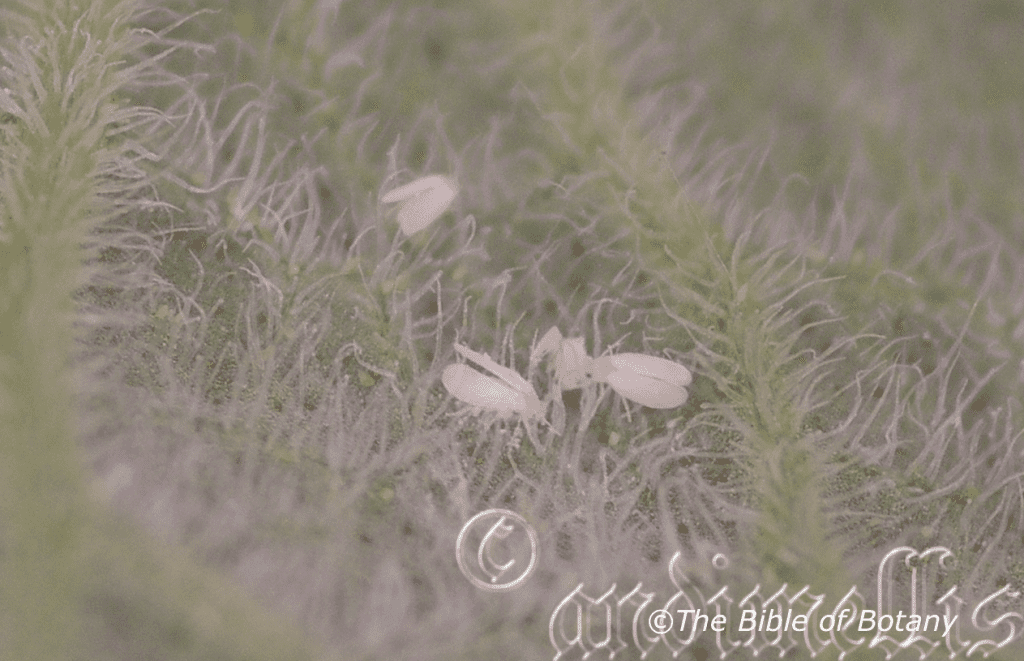
White fly: There is several specie of white fly which are not a problem in outdoor situations in the garden where predators are always stalking. The problem occurs in enclosed warm humid areas, particularly where insecticides have eliminated natural predators giving the sap suckers a free range to garden crops.
Encarsia formosa is a small parasitic wasp with a big reputation in eliminating white fly but it is very susceptible itself to the dangers of insecticides succumbing both directly and indirectly through their residues.
Eretmocerus hayati has been released in Queensland for a specific white fly however it also succumbs to insecticide residues very quickly so is best suited to the organic farmer who resists the temptation of toxicities.
Further Comments from Members:
All information is included in good faith and has been thoroughly researched prior to printing. The website or the author does not warrant or guarantee the accuracy of any information on these pages, nor does the website or the author accept any responsibility for any loss arising from the use of the information found within. The views and opinions are strictly those of the author or those members who chose to actively participate in the contents herein.
“Hi reader, it seems you use The Bible of Botany a lot. That’s great as we have great pleasure in bringing it to you! It’s a little awkward for us to ask, but our first aim is to purchase land approximately 1,600 hectares to link several parcels of N.P. into one at The Pinnacles NSW Australia, but we need your help. We’re not salespeople. We’re amateur botanists who have dedicated over 30 years to saving the environment in a practical way. We depend on donations to reach our goal. If you donate just $5, the price of your coffee this Sunday, We can help to keep the planet alive in a real way and continue to bring you regular updates and features on Australian plants all in one Botanical Bible. Any support is greatly appreciated. Thank you.”
In the spirit of reconciliation we acknowledge the Bundjalung, Gumbaynggirr and Yaegl and all aboriginal nations throughout Australia and their connections to land, sea and community. We pay our respect to their Elders past, present and future for the pleasures we have gained.